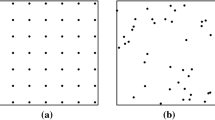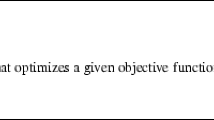Abstract
This paper develops a bi-objective model for determining the location, size, and shape of a finite-size facility. The objectives are to minimize both the closest and barrier distances. The closest distance represents the accessibility of customers, whereas the barrier distance represents the interference to travelers. The distributions of the closest and barrier distances are derived for a rectangular facility in a rectangular city where the distance is measured as the rectilinear distance. The analytical expressions for the distributions demonstrate how the location, size, and shape of the facility affect the closest and barrier distances. A numerical example shows that there exists a trade-off between the closest and barrier distances.












Similar content being viewed by others
References
Amiri-Aref M, Javadian N, Tavakkoli-Moghaddam R, Baboli A (2013) A new mathematical model for the Weber location problem with a probabilistic polyhedral barrier. Int J Prod Res 51:6110–6128
Aneja Y, Parlar M (1994) Algorithms for Weber facility location in the presence of forbidden regions and/or barriers to travel. Transp Sci 28:70–76
Batta R, Ghose A, Palekar U (1989) Locating facilities on the Manhattan metric with arbitrarily shaped barriers and convex forbidden regions. Transp Sci 23:26–36
Bischoff M, Klamroth K (2007) An efficient solution method for Weber problems with barriers based on genetic algorithms. Eur J Oper Res 177:22–41
Bischoff M, Fleischmann T, Klamroth K (2009) The multi-facility location-allocation problem with polyhedral barriers. Comput Oper Res 36:1376–1392
Brimberg J, Wesolowsky G (2000) Note: facility location with closest rectangular distances. Nav Res Logist 47:77–84
Brimberg J, Wesolowsky G (2002a) Locating facilities by minimax relative to closest points of demand areas. Comput Oper Res 29:625–636
Brimberg J, Wesolowsky G (2002b) Minisum location with closest Euclidean distances. Ann Oper Res 111:151–165
Brimberg J, Walker J, Love R (2007) Estimation of travel distances with the weighted \(\ell _p\) norm: some empirical results. J Transp Geogr 15:62–72
Brimberg J, Juel H, Körner M, Schöbel A (2014) Locating an axis-parallel rectangle on a Manhattan plane. Top 22:185–207
Butt S, Cavalier T (1996) An efficient algorithm for facility location in the presence of forbidden regions. Eur J Oper Res 90:56–70
Carrizosa E, Conde E, Muñoz-Márquez M, Puerto J (1995) The generalized Weber problem with expected distances. RAIRO Recherche Opérationnelle 29:35–57
Carrizosa E, Muñoz-Márquez M, Puerto J (1998) Location and shape of a rectangular facility in \(\mathbb{R}^n\). Convexity properties. Math Program 83:277–290
Chien S, Schonfeld P (1997) Optimization of grid transit system in heterogeneous urban environment. J Transp Eng 123:28–35
Daganzo C (2010) Structure of competitive transit networks. Transp Res Part B 44:434–446
Dearing P, Segars R (2002a) An equivalence result for single facility planar location problems with rectilinear distance and barriers. Ann Oper Res 111:89–110
Dearing P, Segars R (2002b) Solving rectilinear planar location problems with barriers by a polynomial partitioning. Ann Oper Res 111:111–133
Dearing P, Hamacher H, Klamroth K (2002) Dominating sets for rectilinear center location problems with polyhedral barriers. Nav Res Logist 49:647–665
Dearing P, Klamroth K, Segars R (2005) Planar location problems with block distance and barriers. Ann Oper Res 136:117–143
Farahani R, SteadieSeifi M, Asgari N (2010) Multiple criteria facility location problems: a survey. Appl Math Model 34:1689–1709
Frieß L, Klamroth K, Sprau M (2005) A wavefront approach to center location problems with barriers. Ann Oper Res 136:35–48
Griffith D, Vojnovic I, Messina J (2012) Distances in residential space: implications from estimated metric functions for minimum path distances. GISci Remote Sens 49:1–30
Hamacher H, Klamroth K (2000) Planar Weber location problems with barriers and block norms. Ann Oper Res 96:191–208
Imai K, Imai H, Tokuyama T (1999) Maximin location of convex objects in a polygon and related dynamic Voronoi diagrams. J Oper Res Soc Jpn 42:45–58
Katz I, Cooper L (1981) Facility location in the presence of forbidden regions, I: formulation and the case of Euclidean distance with one forbidden circle. Eur J Oper Res 6:166–173
Kelachankuttu H, Batta R, Nagi R (2007) Contour line construction for a new rectangular facility in an existing layout with rectangular departments. Eur J Oper Res 180:149–162
Klamroth K (2001) A reduction result for location problems with polyhedral barriers. Eur J Oper Res 130:486–497
Klamroth K (2004) Algebraic properties of location problems with one circular barrier. Eur J Oper Res 154:20–35
Koshizuka T (1984) On methods of analysing spatial patterns composed of parks and open spaces. J City Plan Inst Jpn 19:313–318 (in Japanese)
Kurita O (1991) Location models for a facility with some area. J City Plan Inst Jpn 26:535–540 (in Japanese)
Larson R, Sadiq G (1983) Facility locations with the Manhattan metric in the presence of barriers to travel. Oper Res 31:652–669
Love R, Morris J (1979) Mathematical models of road travel distances. Manag Sci 25:130–139
McGarvey R, Cavalier T (2003) A global optimal approach to facility location in the presence of forbidden regions. Comput Ind Eng 45:1–15
Miyagawa M (2012) Rectilinear distance to a facility in the presence of a square barrier. Ann Oper Res 196:443–458
Miyagawa M (2014) Optimal allocation of area in hierarchical road networks. Ann Reg Sci 53:617–630
Nandikonda P, Batta R, Nagi R (2003) Locating a 1-center on a Manhattan plane with “arbitrarily” shaped barriers. Ann Oper Res 123:157–172
Nickel S, Puerto J, Rodríguez-Chía A (2003) An approach to location models involving sets as existing facilities. Math Oper Res 28:693–715
Nickel S, Puerto J, Rodríguez-Chía A (2005) MCDM location problems. In: Figueria J, Greco S, Ehrgott M (eds) Multiple criteria decision analysis: state of the art surveys. Springer, New York, pp 761–795
Okabe A, Boots B, Sugihara K, Chiu S (2000) Spatial tessellations: concepts and applications of Voronoi diagrams. Wiley, Chichester
Sarkar A, Batta R, Nagi R (2005) Planar area location/layout problem in the presence of generalized congested regions with the rectilinear distance metric. IIE Trans 37:35–50
Sarkar A, Batta R, Nagi R (2007) Placing a finite size facility with a center objective on a rectangular plane with barriers. Eur J Oper Res 179:1160–1176
Savaş S, Batta R, Nagi R (2002) Finite-size facility placement in the presence of barriers to rectilinear travel. Oper Res 50:1018–1031
Shiode N (1995) A study on optimization of the shape and location of spatial facilities. J City Plan Inst Jpn 30:559–564 (in Japanese)
Wang S, Bhadury J, Nagi R (2002) Supply facility and input/output point locations in the presence of barriers. Comput Oper Res 29:685–699
Zhang M, Savas S, Batta R, Nagi R (2009) Facility placement with sub-aisle design in an existing layout. Eur J Oper Res 197:154–165
Acknowledgments
This research was supported by JSPS Grant-in-Aid for Scientific Research. I am grateful to the anonymous reviewers for their helpful comments and suggestions.
Author information
Authors and Affiliations
Corresponding author
Appendices
Appendix 1: Distribution of the closest distance
The distribution of the closest distance is given by
where
Appendix 2: Total closest distance
The total closest distance is given by
where
Rights and permissions
About this article
Cite this article
Miyagawa, M. Continuous location model of a rectangular barrier facility. TOP 25, 95–110 (2017). https://doi.org/10.1007/s11750-016-0424-1
Received:
Accepted:
Published:
Issue Date:
DOI: https://doi.org/10.1007/s11750-016-0424-1




